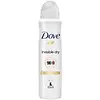Nivea Double Effect Anti-Perspirant Deodorant Spray Versus Dove Invisible Dry Anti-Perspirant Deodorant
What's inside
What's inside
 Key Ingredients
Key Ingredients

No key ingredients
 Benefits
Benefits

 Concerns
Concerns

 Ingredients Side-by-side
Ingredients Side-by-side

Butane
Water
Skin ConditioningIsobutane
Propane
Cyclomethicone
EmollientAluminum Chlorohydrate
AstringentDicaprylyl Carbonate
EmollientC12-15 Alkyl Benzoate
AntimicrobialDicaprylyl Ether
EmollientButyloctanoic Acid
CleansingPersea Gratissima Oil
Skin ConditioningCetyl PEG/PPG-10/1 Dimethicone
EmulsifyingPolyglyceryl-2 Dipolyhydroxystearate
Skin ConditioningPhenoxyethanol
PreservativePolysorbate 65
EmulsifyingButane
Isobutane
Propane
Aluminum Chlorohydrate
AstringentPPG-14 Butyl Ether
Skin ConditioningCyclomethicone
EmollientParfum
MaskingQuaternium-18 Hectorite
Helianthus Annuus Seed Oil
EmollientC12-15 Alkyl Benzoate
AntimicrobialOctyldodecanol
EmollientBHT
AntioxidantDimethiconol
EmollientAlpha-Isomethyl Ionone
PerfumingBenzyl Alcohol
PerfumingBenzyl Salicylate
PerfumingButylphenyl Methylpropional
PerfumingCinnamyl Alcohol
PerfumingCitronellol
PerfumingCoumarin
PerfumingGeraniol
PerfumingHexyl Cinnamal
PerfumingHydroxycitronellal
PerfumingHydroxyisohexyl 3-Cyclohexene Carboxaldehyde
MaskingLimonene
PerfumingLinalool
PerfumingButane, Isobutane, Propane, Aluminum Chlorohydrate, PPG-14 Butyl Ether, Cyclomethicone, Parfum, Quaternium-18 Hectorite, Helianthus Annuus Seed Oil, C12-15 Alkyl Benzoate, Octyldodecanol, BHT, Dimethiconol, Alpha-Isomethyl Ionone, Benzyl Alcohol, Benzyl Salicylate, Butylphenyl Methylpropional, Cinnamyl Alcohol, Citronellol, Coumarin, Geraniol, Hexyl Cinnamal, Hydroxycitronellal, Hydroxyisohexyl 3-Cyclohexene Carboxaldehyde, Limonene, Linalool
 Reviews
Reviews

Ingredients Explained
These ingredients are found in both products.
Ingredients higher up in an ingredient list are typically present in a larger amount.
Aluminum Chlorohydrate has astringent, deodorant, antiperspirant, and water purifying properties.
Due to its astringent properties, this ingredient may be drying.
Aluminum chlorohydrate is one of the most common active ingredients found in antiperspirants. It works by temporarily blocking sweat ducts, reducing the amount of sweat that reaches the surface of the skin.
Despite its long history of use, rumors and misconceptions about aluminum chlorohydrate persist.
Scientific consensus and major health organizations have repeatedly concluded that aluminum chlorohydrate, when used as directed in cosmetic products like antiperspirants, is safe.
The persistent rumors connecting aluminum chlorohydrate to cancer, Alzheimer’s disease, or “toxin buildup” are not supported by credible evidence.
If you’re comfortable with aluminum-based antiperspirants, there is no scientifically backed reason to fear them.
If you prefer to avoid them, plenty of aluminum-free options exist - but that choice usually comes down to personal preference rather than proven health risks.
Learn more about Aluminum ChlorohydrateButane is a gas derived from petroleum and natural gas. It is used as an aerosol propellant.
C12-15 Alkyl Benzoate is made up of Benzoic Acid and long chain alcohols. It has a low molecular weight.
C12-15 Alkyl Benzoate is an emollient and texture enhancer. Due to its solubility, it is often used in sunscreens to help evenly distribute active ingredients.
As an emollient, C12-15 Alkyl Benzoate helps soften and hydrate your skin. Emollients create a film on your skin that traps moisture within.
This ingredient has been reported to cause eye irritation.
Learn more about C12-15 Alkyl BenzoateCyclomethicone is a class of silicones used to improve the texture of products.
Their cyclic or circular structure decreases stability. This causes quick evaporation when applied to skin. Cyclomethicones are often used as a carrier for other ingredients. Once it evaporates, it leaves a silky barrier on the skin.
The most popular types of cyclomethicones include D5 and D6.
Learn more about CyclomethiconeWe don't have a description for Isobutane yet.
Propane is a gas derived from petroleum and natural gas. It is used as a propellant.
This ingredient is most commonly used in shaving cream, hair products, and makeup.